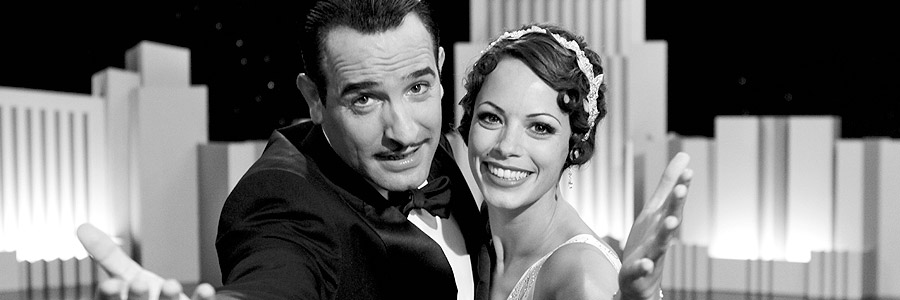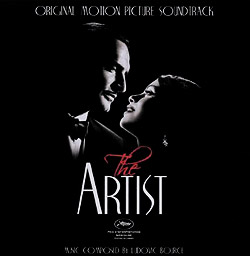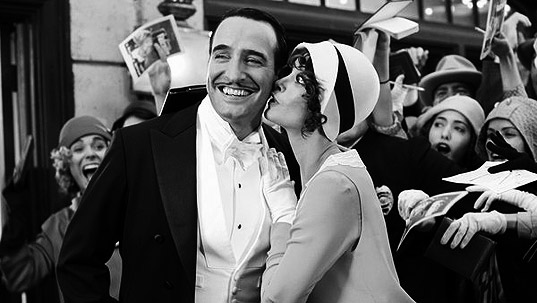
The Artist

THE ARTIST (CD)
Sony Classical
Release date:
January 2nd, 2012
Running time:
73:39 minutes
Composer: Ludovic Bource
Between 1894-1929, films were created to tell a story through a sequence of images and sound that create continuous movement. These films contained no dialogue, often using comedic gestures and title cards to portray messages to the audience. But maybe the most important part of the silent film, the part that really created the magic of the movie, was the accompanying music.
During the silent era, a live pianist or orchestra often accompanied movies, playing music to drive the continuity of the scenes of the film. With Ludovic Bource’s soundtrack for The Artist, he has managed to create this continuity and combine it brilliantly with great orchestration. Whilst he has still maintained the feel of the period, we are reminded just how far things have evolved over the past ninety years.
The Artist, directed by Michel Hazanavicius, is a French comedy-drama set in Hollywood between 1927 and 1932. It tells the story of an actor with a plummeting  career and a rising actress who is starting to blossom within the public eye during the period when the silent film begins to be replaced by the ‘talkies’. What follows is the typical Hollywood story – the rise, the fall and the romance.
career and a rising actress who is starting to blossom within the public eye during the period when the silent film begins to be replaced by the ‘talkies’. What follows is the typical Hollywood story – the rise, the fall and the romance.
From the grandeur opening of The Artist Ouverture, reminiscent of something from an opening to a major West End production, there is an instant observation that this score will tell the movie, with or without the images. Bource uses the perfect balance to create the melodramatic feel of Hollywood in the 1920’s, using original compositions combined with classics such as Jubilee Stomp (Duke Ellington), Imagination (Red Nichols and His Five Pennies) and Pennies from Heaven (Rose Murphy), the only song within the score.
The playful piano and marimba melodies accompanied by a walking bass line in George Valentin create an instant image of a charming, happy-go-lucky individual from that time. It enables us to create an impression of his character through the music rather than through his words. Much the same with Pretty Peppy, where the music allows us to envisage the beauty, grace and exuberance of this ‘woman in a carefree world’, regardless of whether we have seen her character visually or not.
Silent Rumble takes on a much more urgent nature to begin with, combining sweeping tremolo strings, sharp stabs of woodwind and ceremonious brass fanfares. The timbre of the instruments and the interpretation changes the mood of the scene instantaneously.
- 1. The Artist Ouverture
- 2. 1927 A Russian Affair
- 3. George Valentin
- 4. Pretty Peppy
- 5. At the Kinograph Studios
- 6. Fantaisie D’amour
- 7. Waltz for Peppy
- 8. Estancia op. 8 Composed by Alberto Ginastera
- 9. Imagination Composed by Livingston
- 10. Silent Rumble
- 11. 1929
- 12. In the Stairs
- 13. Jubilee Stomp Performed by Duke Ellington
- 14. Comme Une Rosée De Larmes
- 15. The Sound of Tears
- 16. Pennies from Heaven Composed by Johnny Burke
- 17. 1931
- 18. Jungle Bar
- 19. L’ombre Des Flammes
- 20. Happy Ending…
- 21. Charming Blackmail
- 22. Ghosts from the Past
- 23. My Suicide (Dedicated 03.29.1967)
- 24. Peppy and George
Bource’s music echoes the characters personalities throughout, and we are reminded of this constantly. For example, the use of the lively marimba melody in George Valentin makes a return later in the score, but in a much darker passage, representing the downward spiral that he has come to find himself confronting.
By the time we reach Ghosts from the Past, dissonant string and brass melodies alter the mood completely, and we are thrown into despair and tragedy.
For me personally, the most touching track is My Suicide (Dedicated To 03.29.1967) with its haunting melody, high strings and dissonant woodwind harmonies; it yet again changes the mood. It is in my opinion the most traditionally classical track from the score, and it could easily stand-alone as a piece of music for that reason.
The score for The Artist really does cover everything – it is majestic, humorous, lively, tense: the list goes on. It covers heavy emotional themes ranging from one extreme to the other, and it  manages to do this whilst still maintaining the feel of the time and place in which it is set. The ability of Bource to orchestrate such a score clearly displays that he has worked hard to capture the essence of the period. It is a splendidly descriptive score, which enhances the emotions of the characters and the situations they find themselves in frame by frame. It would be interesting to see how The Artist would be perceived by an audience should it ever be made into a ‘talkie’.
manages to do this whilst still maintaining the feel of the time and place in which it is set. The ability of Bource to orchestrate such a score clearly displays that he has worked hard to capture the essence of the period. It is a splendidly descriptive score, which enhances the emotions of the characters and the situations they find themselves in frame by frame. It would be interesting to see how The Artist would be perceived by an audience should it ever be made into a ‘talkie’.
It amazes me that Bource had no formal training in composition. He did study music as a child, but to have had no experience in orchestration and to be able to create a score such as this is unbelievable.
Maybe this is the start of the return of the silent film, and if it is, I look forward to what the many fantastic composers such as Bource have to offer.

Phil Blanckley
Phil is a 27-year-old classically trained musician from Sheffield with qualifications in Popular Music, Classical Music and a BA (Hons) in Creative Music Technology and Sound Recording. He likes nothing better than locking himself in the studio and composing music of all genres.
Phil became interested in composing after learning how to play the Cello and Clarinet at a young age, and has never looked back since. His favourite composer is Danny Elfman, whose unconventional harmonies and rhythms in scores such as Edward Scissorhands still manage to bring a tear or two to his eye.
You can find him on Twitter @PhilBlanckley.
© 2022 STATIC MASS EMPORIUM . All Rights Reserved. Powered by METATEMPUS | creative.timeless.personal. | DISCLAIMER, TERMS & CONDITIONS
HOME | ABOUT | CONTACT | TWITTER | GOOGLE+ | FACEBOOK | TUMBLR | YOUTUBE | RSS FEED
CINEMA REVIEWS | BLU-RAY & DVD | THE EMPORIUM | DOCUMENTARIES | WORLD CINEMA | CULT MOVIES | INDIAN CINEMA | EARLY CINEMA
MOVIE CLASSICS | DECONSTRUCTING CINEMA | SOUNDTRACKS | INTERVIEWS | THE DIRECTOR’S CHAIR | JAPANESE CINEMA





